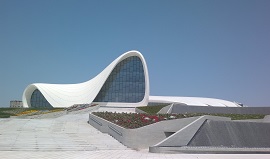Main author
Michael BrooksThe Architecture of Neoliberalism
Douglas Spencer - ‘The Architecture of Neoliberalism: How contemporary architecture became an instrument of control and compliance’
Published by Bloomsbury Academic (2016)
When Zaha Hadid died in 2016, she was celebrated as one of the 21st century’s most influential and visionary architects. Buildings such as the Guangzhou Opera House, the London Aquatics Centre, and the Heydar Aliyev Cultural Centre demonstrated a radical and futuristic aesthetic that was very much her own.
However, her critics also made mention of the human rights controversies which dogged her later career; in particular, the building of the Qatar World Cup Stadium, for which she claimed an abdication of responsibility.
More recently, Hadid’s successor, Patrick Schumacher, attracted considerable opprobrium when he advocated untrammelled gentrification and the privatisation of all social housing and public space, including Hyde Park.
According to Douglas Spencer, such pronouncements and controversies, far from being isolated events, are very much bound up in the architecture of neoliberalism that has developed over the last couple of decades, and which he critiques in his challenging and uncompromising book.
Neoliberalism is one of those buzzwords that is often used but seldom completely understood. In short it is a form of capitalism that promotes shrinking the state and public services in favour of privatisation, and any notion of the 'common good' is surrendered to the ‘logic of the market'. It was developed as an ideology by the likes of Hayek and Friedman, and introduced in the West by Thatcher and Reagan in the 1980s.
Spencer’s book is perhaps the first to analyse neoliberalism in conjunction with its architectural expressions. He joins the intellectual dots from 20th century countercultural thinkers such as Foucault and Lefevre, to some of the 21st century’s most celebrated architectural practices. In addition to Hadid and Schumacher, the book provides incisive analysis of the likes of Rem Koolhaas, Alejandro Zaera-Polo and Greg Lynn, and deconstructs buildings such as the CCTV Headquarters in Beijing, Birmingham New Street station, and the BMW factory in Leipzig.
Overall, this is a complex and tough read, which will likely only appeal to those steeped in architectural theory and criticism. But that does not make the book any less important or timely. Indeed at this disorientating time of change, when the foundations of the neoliberal ideology appear to be buckling beneath the weight demonstrable failures, it is a powerful and instructive piece of work.
To find out more and purchase the book click here.
[edit] Find out more
[edit] Related articles on Designing Buildings Wiki
- Charles Waldheim - Landscape as Urbanism: A General Theory.
- Interview with Tom Dyckhoff.
- Last Futures: Nature, Technology and the End of Architecture.
- Living in the hyperreal post-modern city.
- Neo-futurism.
- Public space intervention.
- Owen Hatherley - Landscapes of Communism.
- The architectural profession.
- Zaha Hadid.
Featured articles and news
A threat to the creativity that makes London special.
How can digital twins boost profitability within construction?
A brief description of a smart construction dashboard, collecting as-built data, as a s site changes forming an accurate digital twin.
Unlocking surplus public defence land and more to speed up the delivery of housing.
The Planning and Infrastructure bill oulined
With reactions from IHBC and others on its potential impacts.
Farnborough College Unveils its Half-house for Sustainable Construction Training.
Spring Statement 2025 with reactions from industry
Confirming previously announced funding, and welfare changes amid adjusted growth forecast.
Scottish Government responds to Grenfell report
As fund for unsafe cladding assessments is launched.
CLC and BSR process map for HRB approvals
One of the initial outputs of their weekly BSR meetings.
Architects Academy at an insulation manufacturing facility
Programme of technical engagement for aspiring designers.
Building Safety Levy technical consultation response
Details of the planned levy now due in 2026.
Great British Energy install solar on school and NHS sites
200 schools and 200 NHS sites to get solar systems, as first project of the newly formed government initiative.
600 million for 60,000 more skilled construction workers
Announced by Treasury ahead of the Spring Statement.
The restoration of the novelist’s birthplace in Eastwood.
Life Critical Fire Safety External Wall System LCFS EWS
Breaking down what is meant by this now often used term.
PAC report on the Remediation of Dangerous Cladding
Recommendations on workforce, transparency, support, insurance, funding, fraud and mismanagement.
New towns, expanded settlements and housing delivery
Modular inquiry asks if new towns and expanded settlements are an effective means of delivering housing.

























